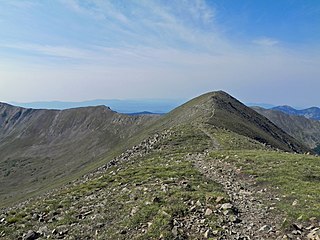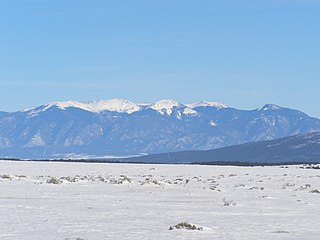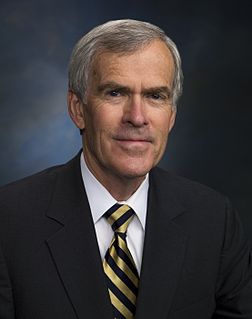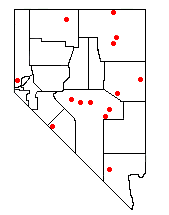| Columbine-Hondo Wilderness | |
|---|---|
IUCN category Ib (wilderness area) | |
| Location | Taos County, New Mexico, United States |
| Area | 44,698 acres (18,089 ha) |
| Established | 2014-12-19 |
| Governing body | U.S. Forest Service |
Coordinates: 36°38′37″N105°27′22″W / 36.64361°N 105.45611°W Columbine-Hondo Wilderness is a 44,698-acre (18,089 ha) Wilderness area located within the Carson National Forest in New Mexico. The area was added to the National Wilderness Preservation System on December 19, 2014 by Public Law 113-291. [1] Located in the Sangre de Cristo Mountains, this area contains the headwaters to the Rio Hondo and Red River as well as three peaks which rise to or above timberline. [2]

A geographic coordinate system is a coordinate system that enables every location on Earth to be specified by a set of numbers, letters or symbols. The coordinates are often chosen such that one of the numbers represents a vertical position and two or three of the numbers represent a horizontal position; alternatively, a geographic position may be expressed in a combined three-dimensional Cartesian vector. A common choice of coordinates is latitude, longitude and elevation. To specify a location on a plane requires a map projection.
A wilderness area is a region where the land is in a natural state; where impacts from human activities are minimal—that is, as a wilderness. It might also be called a wild or natural area. Especially in wealthier, industrialized nations, it has a specific legal meaning as well: as land where development is prohibited by law. Many nations have designated Wilderness Areas, including Australia, Canada, New Zealand, South Africa and the United States.

Carson National Forest is a national forest in northern New Mexico, United States. It encompasses 6,070 square kilometers and is administered by the United States Forest Service. The Forest Service's "mixed use" policy allows for its use for recreation, grazing, and resource extraction.
Elevations in the wilderness range from 2,396 metres (7,861 ft) to 3,874 metres (12,710 ft) at Gold Hill. The other principal summits of the wilderness area are Lobo Peak (3,692 metres (12,113 ft)) and Flag Mountain (3,641 metres (11,946 ft)). The Colombine-Hondo Wilderness is separated from the Wheeler Peak Wilderness to the south only by Highway 150 and the Taos Ski Valley. Latir Peak Wilderness is located north of Colombine- Hondo Wilderness. [3]

The 19,661-acre (7,957 ha) Wheeler Peak Wilderness lies in the Carson National Forest of New Mexico. It contains the highest point in the state, 13,161-foot (4,011 m) Wheeler Peak as well as Williams Lake.

Latir Peak Wilderness is a 20,506-acre (8,298 ha) wilderness area located within the Carson National Forest in northern New Mexico, United States. Designated in 1980, the wilderness is composed of dense forest, meadows, and alpine tundra on Latir Mesa in the northern portion. It includes a portion of the Sangre de Cristo Mountains and contains four of the state's twenty highest peaks - Venado Peak at 12,734 feet (3,881 m), Latir Peak at 12,708 feet (3,873 m), Latir Mesa at 12,692 feet (3,869 m), and Virsylvia Peak at 12,594 feet (3,839 m). Most of the area is drained by the Lake Fork of Cabresto Creek, which originates at Heart Lake and is impounded just outside the wilderness in Cabresto Lake, the main trailhead for visitors entering the wilderness.
The wilderness has vegetation typical of the southern Rocky Mountains with Ponderosa Pine and Pinyon forests at lower elevations, mixed conifers and aspens at the middle elevations, spruce-fir forests at higher elevations, and alpine tundra above treeline.

The Rocky Mountains, also known as the Rockies, are a major mountain range in western North America. The Rocky Mountains stretch more than 4,800 kilometers (3,000 mi) from the northernmost part of British Columbia, in western Canada, to New Mexico in the Southwestern United States. Located within the North American Cordillera, the Rockies are somewhat distinct from the Pacific Coast Ranges, Cascade Range, and the Sierra Nevada, which all lie farther to the west.

The pinyon or piñon pine group grows in the southwestern United States, especially in New Mexico, Arizona, and Utah. The trees yield edible nuts, which are a staple food of Native Americans, and widely eaten as a snack and as an ingredient in New Mexican cuisine. The name comes from the Spanish pino piñonero, a name used for both the American varieties and the stone pine common in Spain, which also produces edible nuts typical of Mediterranean cuisine. Harvesting techniques of the prehistoric American Indians are still used today to collect the pinyon seeds for personal use or for commercialization. The pinyon nut or seed is high in fats and calories.

Aspen is a common name for certain tree species; some, but not all, are classified by botanists in the section Populus, of the Populus genus.

















